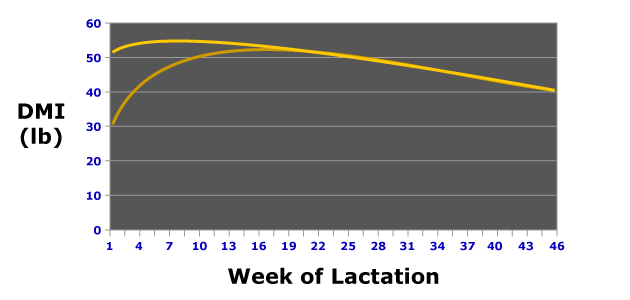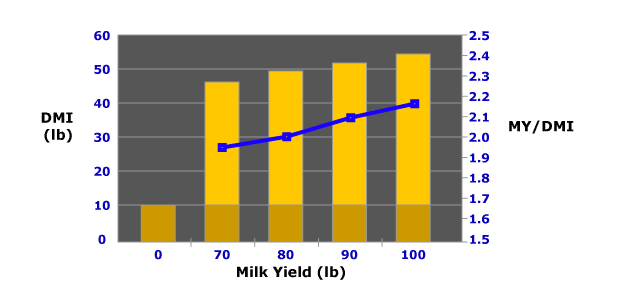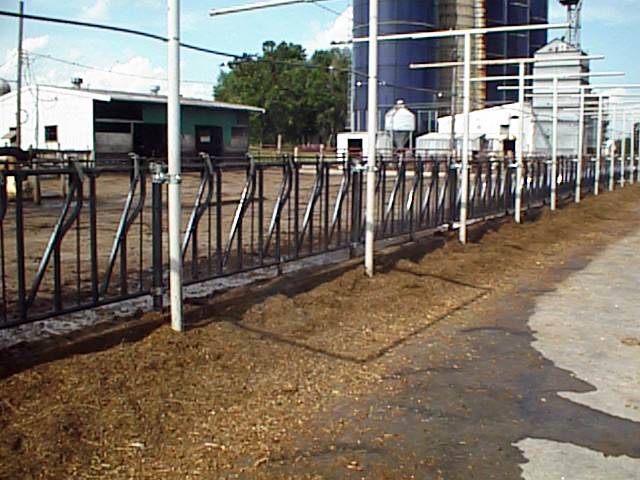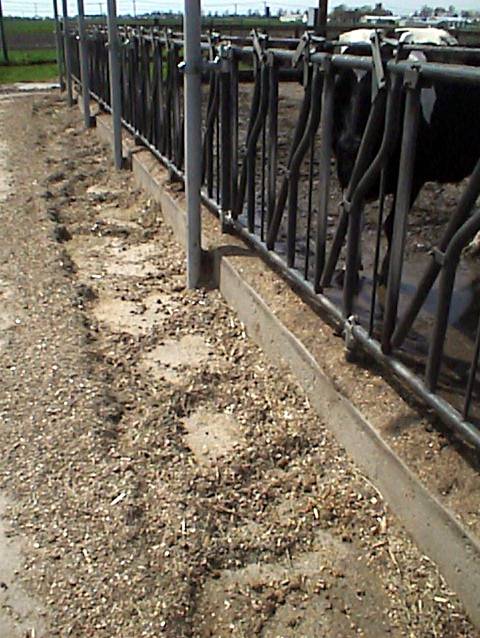Previous Page | Right click this page to print.
Dry Matter Intake
Dry matter intake and the importance of feed intake in lactating dairy
cows. Milk yield is positively correlated to dry matter intake. For every
pound of additional intake that a cow consumes, we can expect about two
pounds of milk. There are several factors that affect intake, two of these
being dependent upon the cow. Body weight of the cow, larger cows consume
more feed. Also the milk yield, the more milk a cow gives, the more intake
she will consume. The second component affecting intake is the ration.
Moisture content has an effect through high moisture rations or those
that contain little dry matter. Mainly, this is from feeding excess silage
to cows such as corn silage which can be unpalatable when fed at high
levels of intake. The second component is the effect of the ration on
rumen pH. Remember, if excess grain is fed, rumen pH declines, passage
rate of feed in the GI tract declines and intake will decline. Too much
fat in the diet, as we talked about in the last section, can drive intake
down. If there is too little effective fiber, this can also depress intake.
Nutrient densities, if they are too low, if energy density is too low
or crude protein density is too low, this will decrease intake. And the
bulk density or how much fiber is in the diet. Remember that too much
fiber leads to filling capacity of the rumen and depresses intake and
also too little fiber and therefore too much grain can lower intake. The
third is general management, especially of the bunk. How often bunks are
cleaned or how often feed refusals are cleaned from the bunk and this
should be done daily. How often cows are fed per day, the more feedings
per day increases intake. And also how often feed is pushed up in the
bunk. Excess crowding or over-crowding can reduce intake due to social
stress or social pressure within the groups. How many hours cows have
access to feed. Ideally, cows would have access to feed 24 hours a day.
On the opposite side of cleaning the refusals, is that there is some feed
left in the bunk before each feeding to ensure that cows have free access
to feed. Behavioral characteristics within the groups. It has been shown
that if you group younger animals together, or first lactation heifers,
they will consume more feed and produce more milk versus if they are comingled
with older cows. The environment has an effect on feed intake. Higher
temperatures decrease intake, higher humidity also decreases intake. However,
even if we have high daytime temperatures, it has been shown in areas
such as Arizona, New Mexico and Texas, if we have night cooling, or low
night temperatures, we can achieve the same level of feed intake.
This is a simple equation that you can use to predict dry matter intake
of cows.
Take note of this equation, because you will need to complete your first
ration formulation problem set for dairy cows. The equation is dry matter
intake, in kilos per day, equals 0.0968 times body weight to the three
quarter power. That means cows that weigh more will consume more dry matter.
The second component of the equation is .372 times kilograms of fat-corrected
milk. Fat-corrected milk is milk that has been adjusted for or corrected
on a 4% fat basis. The reason we correct milk, is that cows that give
higher fat percentages in their milk are secreting or are producing more
energy in the milk and therefore need to consume more energy or more dry
matter. First, you have to determine how many pounds of fat corrected
milk the cow is producing. For this we also use an equation. Fat corrected
milk equals .4 times the kilograms of milk plus 15 times the kilograms
of fat. Let’s take an example of a 635-kilo cow, producing 36 kilograms
of milk that contains 3.5% of fat. First, we determine how many kilos
of fat corrected milk she is producing. It would be .4 times 36 plus 15
times 1.26 kilograms of fat. We determined the 1.26 from 36 kilos of milk
times .035, which gives us 1.26. If you do the multiplication and sum
these two parts, we will arrive that this cow is giving 32.8 kilos of
4% fat corrected milk. A good check on whether you have completed this
portion of this equation correctly, is that if a cow has been giving exactly
4% fat you do not need to do the corrected milk equation, you do not have
to correct for it because she is giving 4% fat. If she is given more than
4% fat in her milk, the fat corrected milk will always be more than actual
milk yield. And if the cow, as in this case, is giving less than 4% fat,
that means that fat-corrected milk will always be less than actual milk
yield. Now that we have determined fat-corrected milk, we can plug in
our values for body weight and fat corrected milk in terms of dry matter
intake. The equation is 0.0968 times 635 to the three quarter power plus
.372 times 32.8 kilos of fat corrected milk. We would estimate that this
cow would consume 24.7 kilograms of dry matter per day or 54.2 pounds
of dry matter per day.
This is the dry matter intake curve of average cows.

There are two different lines on here. One is a darker orange line that eventually meets the lighter colored line at about 19 to 22 weeks of lactation. If you use the equation that we just talked about and plugged in milk yields and body weights of cows, we would expect cows to consume on the light orange line. However, cows have suppressed intake in early lactation. Actually, there is a lag in intake and it takes about 20 weeks or so for cows to catch up to where they would be, simply based upon the milk yield they are giving. They are not eating as much feed in early lactation as we would expect from the dry matter intake equations.
This graph depicts how many pounds of dry matter goes toward maintenance
and milk for different levels of milk.

We have five different levels of milk, 0, 70, 80, 90, and 100 and we predict their dry matter intake which is on the left axis. Cows giving no milk, or at maintenance, need about 10 pounds of dry matter a day to meet maintenance requirements, and all cows do, regardless of whether they are producing 70 pounds or 100 pounds of milk. Then, we have the dry matter requirement for milk yield, which are the tan bars above the dark orange. We see a cow producing 70 pounds of milk, it would be expected to consume about 36 pounds of dry matter and a cow producing 100, about 46 pounds of dry matter for milk yield plus the additional 10 for maintenance. The way that we would read this graph is for the 100 pound cow, she needs about 46 pounds of dry matter for milk and an additional 10, so a total of 56 for total milk and maintenance requirements. The blue line depicts, and the axis is the right axis, depicts how many pounds of milk we can get per pound of dry matter. You can see if a cow is producing about 70 pounds of milk, it takes about, or we could get, about 1.95 pounds of milk per pound of dry matter and up to those cows producing about 100 pounds, it increases to about 2.15. We see this small increase because these cows producing more milk are more economical, we’re spreading those ten pounds of maintenance feed costs over more pounds of milk.
Here is an example of a line feed bunk with head locks.

So we see no cows there, but we can assume or we can predict that feed is available because it is there in the bunk.
Take a look at this bunk.

Now there is feed there, but is it truly available to the cows? And
it is not. Most of the feed is out of the reach of the cows.
Previous Page | Right click this page to print.